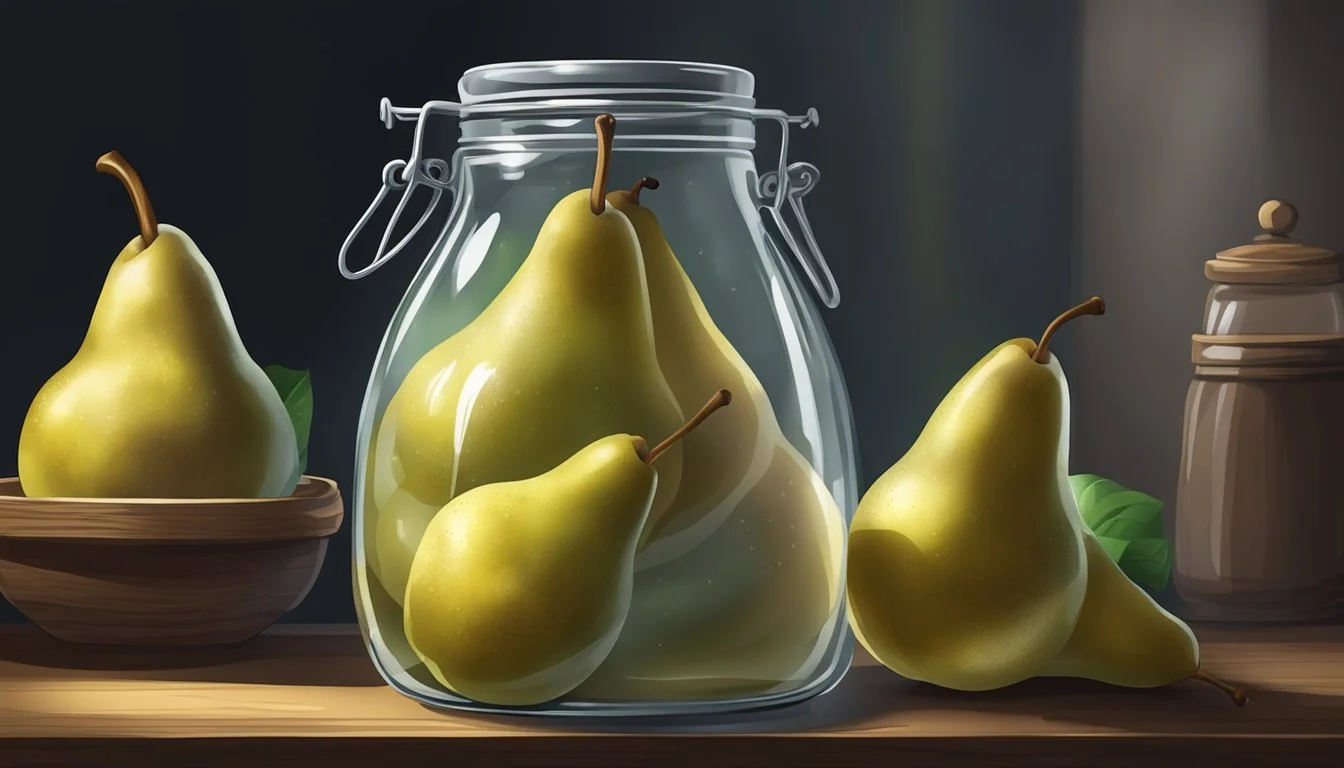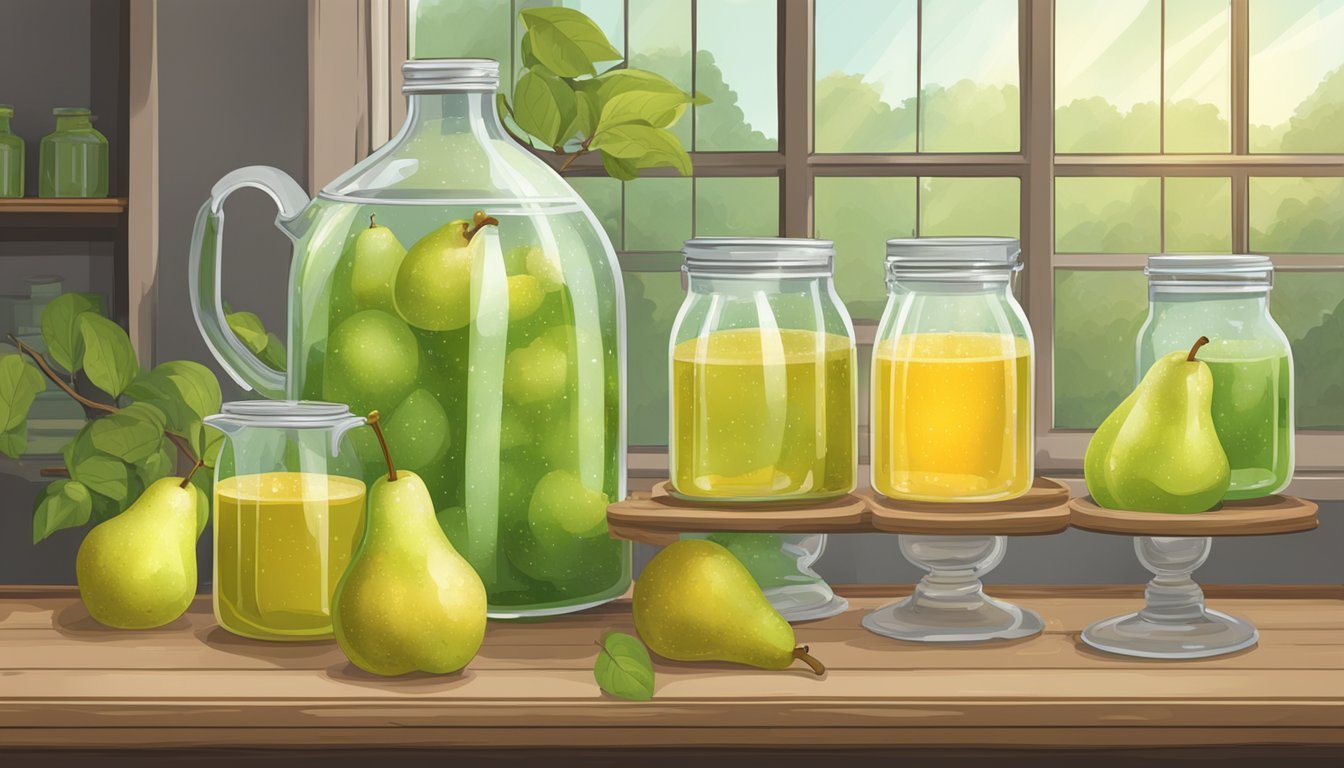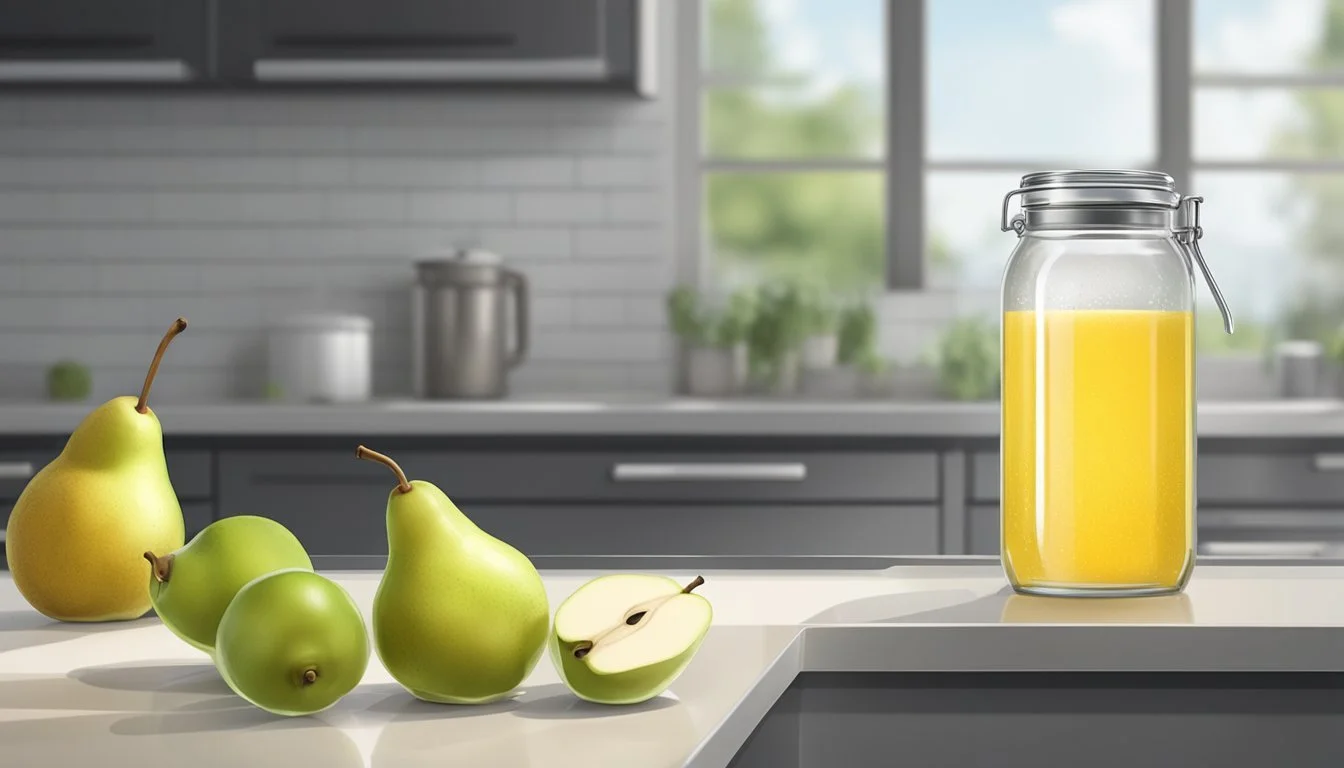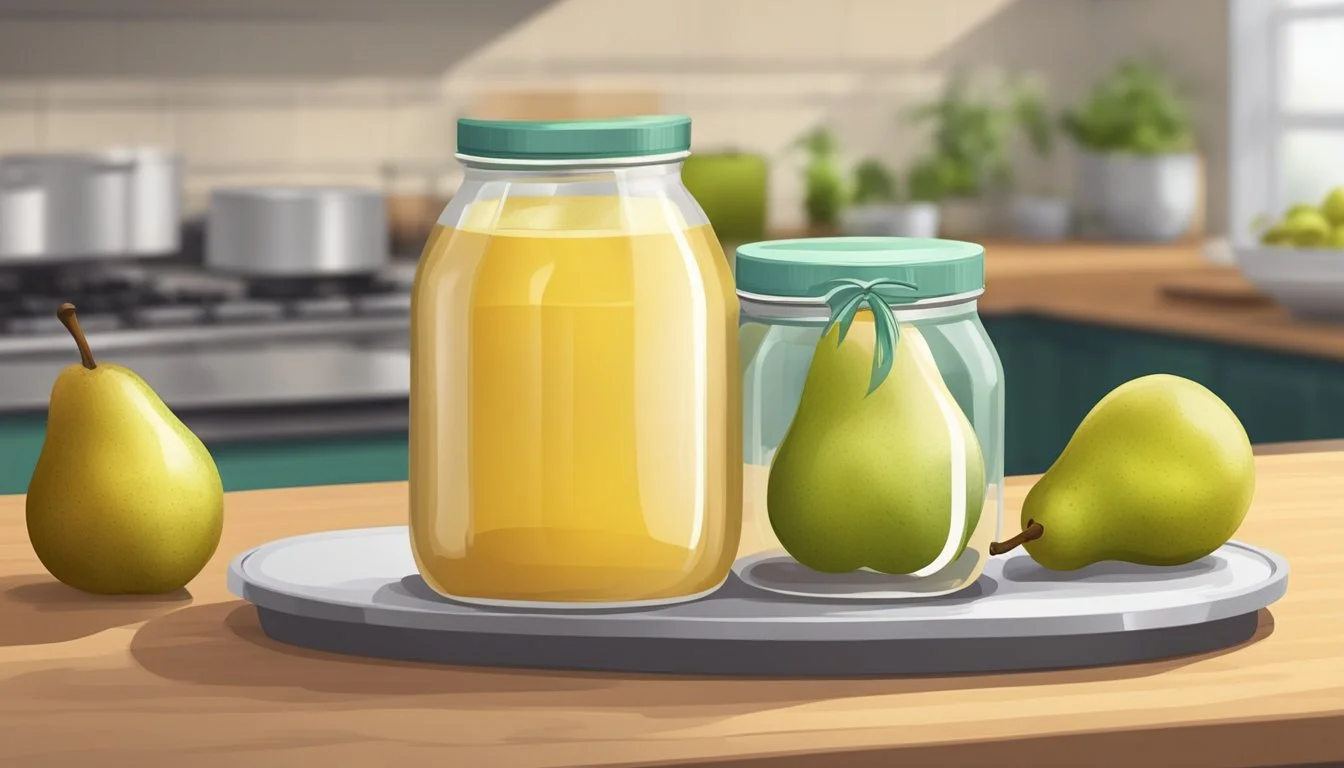How to Ferment Perry
A Step-by-Step Guide to Crafting Pear Cider
Perry is a delightful alcoholic beverage made from fermented pear juice, akin to how cider is made from apples. This traditional drink, which dates back centuries, especially in regions of England and France, has experienced a resurgence of interest among craft brewers and home fermentation enthusiasts. The process of fermenting pears into perry involves selecting the right type of pears, usually specific varieties known as perry pears, and then guiding the natural sugars through fermentation until they yield a pleasingly complex, often slightly effervescent drink.
The fermentation of perry begins with good fruit selection and preparation. Ripe pears are essential, as they provide the sugars necessary for fermentation. They are then washed, and any rotten bits are cut away before being crushed to extract the juice. Care must be taken to sanitize equipment and the fermenting vessel to prevent unwanted bacteria from spoiling the batch. Different recipes might include variations like adding sugar to aid in carbonation, or pectic enzymes to clarify the juice, but fundamentally, the process involves allowing yeast to convert the fruit sugars into alcohol under controlled conditions.
Once the pear juice is placed in a fermenting vessel and yeast is added, the fermentation process gets underway. It is essential to monitor the progress, which includes checking the gravity of the perry to ensure the fermentation is proceeding correctly and keeping the environment stable. After initial fermentation, the perry may be transferred to secondary fermenters to clarify and mature, enhancing its flavors. With patience and attention to detail, the result is a refreshing and nuanced beverage suitable for a variety of occasions.
Overview of Perry and Its History
Perry is an alcoholic beverage made from the fermentation of pear juice, distinct from apple cider. It has deep historical roots, particularly in England and France, with specific perry pears used to achieve its unique taste and characteristics.
Origins of Perry
The production of perry can be traced back to Roman times, although it became more prominent in medieval England and France. In England, the counties of Herefordshire, Gloucestershire, and Worcestershire became renowned for their perry making due to the availability of perry pears - a group of pear varieties specifically cultivated for brewing perry. French regions also developed a tradition of perry making, parallel to their cider production. Over centuries, this craft of fermenting perry pears has been honed, establishing a treasured beverage in European heritage.
Characteristics of Traditional Perry
Traditional perry is known for its subtle yet complex flavor profile. Unlike typical dessert pears, perry pears are higher in tannins and acidity, lending the finished product a fine balance between sweetness and sharpness. The clarity and color can vary, usually presenting a range from pale yellow to a deeper golden hue. In the traditional perry-making process, emphasis is placed on natural fermentation, often resulting in a drink with variations from batch to batch, reflecting the terroir and the specific pear varieties used.
Selecting the Right Pears
The success of fermenting perry begins with selecting the appropriate pear varieties. Quality perry pears are often high in tannins and acids, which contribute to the final beverage's character.
Identifying Perry Pears
Perry pears are specific pear varieties renowned for their excellent fermenting properties. Unlike most table pears, perry pears are higher in acidity and tannins, which are essential for a well-balanced perry. These pears can be quite astringent when eaten fresh but develop a complex profile when fermented. Traditional orchards may still house old pear trees of varieties perfect for perry, boding well for a rich-tasting product.
Choosing Ripe Pears
For the best fermentation results, one should select ripe pears. Ripeness ensures an optimal sugar content necessary for the fermentation process. A ripe pear is typically firm with a slight give when pressed gently, and they often emit a fragrant aroma. It's not just about sweetness; ripe pears will provide the necessary yeast nutrients and contribute to a fuller-bodied perry. Careful timing in an orchard is required, as pears often ripen from the inside out, making outer firmness a deceptive marker.
Other Suitable Pear Varieties
While traditional perry pears are ideal, one can also make perry from a variety of other pears. Sweet pears such as 'Bosc' provide a good sugar base, whereas 'Asian Pears' bring a unique flavor to the blend. When choosing from these other varieties, ensure they exhibit signs of ripeness similar to that of classic perry pears. The use of non-traditional pears may result in a different perry profile but can still yield a delicious fermented product.
Preparation for Fermentation
To achieve successful fermentation of Perry, meticulous preparation sets the stage. This requires thorough cleaning and sanitizing of equipment, as well as the proper handling of the pears through crushing and pressing to obtain the pure juice needed for fermentation.
Cleaning and Sanitizing Equipment
Before one begins the process of fermenting Perry, it is imperative that all equipment is properly cleaned and sanitized. Sanitizing is a step beyond cleaning and involves the use of a chemical solution that kills off any unwanted bacteria that could spoil the cider.
Gather all equipment including fermenters, bottles, caps, tubing, and the cider press.
Wash everything using hot, soapy water to remove any visible debris and residue.
Rinse thoroughly with hot water.
Prepare a sanitizing solution according to the manufacturer's instructions. Common sanitizers include:
Star San
Iodophor
Bleach solution (properly diluted)
Submerge the equipment in the solution, or apply it with a clean spray bottle, ensuring every surface is contacted.
Allow the sanitizer to work for the recommended contact time, usually around 2-3 minutes.
Equipment should be allowed to air dry; do not rinse off the sanitizer as it may reintroduce contaminants.
Crushing and Pressing Pears
After sanitization, attention turns to preparing the pears. The fruit needs to be processed to extract the juice which acts as the base for the cider.
Start by washing the pears thoroughly to remove any dirt or contaminants.
Cut the pears into halves or quarters, removing any rotten parts and the core.
Crushing the pears can be done by hand with a potato masher or mechanically with a fruit crusher to break them down into a pulp.
Once the pears are crushed, the pressing begins. Transfer the pulp into a fruit press or cider press and press slowly to maximize juice extraction.
Collect the pear juice in a sanitized container, ready for the fermentation process.
It's important to remember that the efficiency of juice extraction will impact the volume of Perry that can be fermented. Quality equipment, such as a reliable press and robust containers, ensures that the pear juice retains its integrity before the fermentation begins.
Fermentation Process
The fermentation process of Perry involves preparing a fermentable pear base, introducing yeast for conversion into alcohol, and closely monitoring progress to achieve the desired outcome.
Creating the Fermentable Mixture
One begins by preparing a sugary pear juice mix that yeast will convert into alcohol. Sugar—whether naturally present in pears or added—serves as the fuel for fermentation. To create this mixture:
Wash pears thoroughly, removing stems and any spoiled parts.
Core and cut pears, then crush them to extract juice.
Optional: For additional clarity and flavor, one may add tannin and acid to balance the sweetness.
Enhancing the juice with additional sugars can boost the final alcohol content. It is essential to measure the initial specific gravity with a hydrometer to predict alcohol levels.
Understanding the Role of Yeast
Yeast is a critical player in the fermentation process. It consumes sugars, producing alcohol and carbon dioxide as by-products. To ensure a healthy fermentation:
Pitch an appropriate amount of yeast into the pear juice after it has been prepared and optionally pre-treated with Campden tablets to eliminate wild strains and bacteria.
Incorporate yeast nutrient to aid yeast activity and promote a steady fermentation.
An airlock is vital, as it allows carbon dioxide to escape while keeping external air out, preventing oxidation and contamination.
Monitoring the Fermentation
Vigilant monitoring of Perry fermentation is mandatory. One should:
Keep the fermenting Perry in a cool, dark place.
After the start of primary fermentation, monitor specific gravity regularly to gauge alcohol content and the pace of fermentation.
Transfer the Perry to a secondary fermenter post-primary fermentation to leave behind the yeast cake and clarify the drink.
Confirm that fermentation has ceased before bottling. This can often be indicated by a stable specific gravity over several days.
Refraining from bottling while fermentation is still active is crucial as this could result in excess pressure and potentially burst bottles.
Racking and Clarifying Perry
Racking and clarifying perry are essential steps in the fermentation process to remove sediment and enhance the beverage’s clarity and quality.
Transferring the Fermented Juice
Once the initial fermentation period is completed, the brewer should carefully transfer the liquid from the primary fermentation vessel to a secondary one. This process is done using a siphon, which is a hose specifically designed for transferring liquids without disturbing the sediment that has settled at the bottom. The siphon should be sanitized before use to prevent contamination. To transfer, the hose is inserted just above the sediment layer, ensuring the clearer liquid above is moved while leaving the sediment behind.
Removing Sediment and Clarifying
After transfer, there usually remains fine sediment in the perry that can cause haziness. The application of a pectic enzyme can break down pectin, a substance naturally found in pears which contributes to this haziness. For more effective clarity, the brewer can employ a process known as racking, where the perry is transferred from one container to another multiple times, leaving sediment behind each time. Finally, clarifying can be achieved by a cold crash, which involves lowering the temperature of the perry to near freezing for a brief period, causing the remaining sediment to precipitate out of suspension. After these steps, the perry should appear significantly clearer and ready for maturation or bottling.
Flavoring and Aging
When fermenting perry, a craftsperson’s attention to the balance of sweetness and acidity, along with the patience for aging, can greatly enhance the final product's complexity and taste profile.
Adjusting Sweetness and Acidity
To create a well-balanced perry, one might need to adjust the sweetness and acidity. Sweetness can be modified post-fermentation by adding non-fermentable sweeteners such as lactose or sweetened flavor extracts. However, to retain a natural profile, back-sweetening with a syrup made from pear juice and a stabilizer, like potassium sorbate to prevent further fermentation, can be employed.
Acidity affects a perry's flavor and stability. It can be adjusted using malic acid to add sharpness or citric acid to impart a refreshing citrus note. Tannins can be introduced for added complexity and to provide a slight astringency that enhances the mouthfeel. However, care should be taken as excessive acidity can lead to a product that tastes more like vinegar than a refined perry.
Increase Sweetness: Add non-fermentable sugars or stabilized pear juice syrup.
Increase Acidity: Add malic or citric acid in small increments, tasting along the way.
Add Complexity (Tannins): Introduce tannins through aging on wood or adding tannin powder.
Balance Excessive Acidity: Back-sweeten with non-fermentable sugar or blend with a lower-acid pear juice.
Aging for Finesse
The process of aging perry allows for flavors to meld and mature, often resulting in a beverage with greater finesse. Perry can be aged in bottles or in various containers such as stainless steel tanks or oak barrels. Each vessel imparts different characteristics; oak barrels may introduce woody complexities and tannins, while stainless steel offers a neutral aging environment.
Short-term aging might last a few months, whereas long-term aging spans years, and both timeframes influence the perry’s flavor development. Throughout these periods, it’s crucial to maintain proper storage conditions — a cool, consistent temperature away from light — to safeguard the perry from spoilage and to ensure the graceful development of its flavors.
Bottling and Carbonation
The final steps in crafting Perry require careful bottling and carbonation to ensure the preservation of its flavor and the desired level of effervescence. It is crucial to mix the correct amount of sugar to achieve the sparkle without over-carbonating which can lead to bursting bottles.
Preparing for Bottling
Before bottling, one must ensure that the Perry has finished fermenting and that the desired sweetness is achieved. The fermenter's content should be clear, with no visible yeast activity. Bottles must be sterilized to eliminate any contaminants that could spoil the Perry.
Sanitize all bottles, caps, and bottling equipment.
Measure the sugar content if aiming for a sweet pear cider and adjust according to taste.
Rack the Perry from the fermenter, leaving behind any sediment, to a clean container.
Carbonating Perry for Sparkle
Carbonation is achieved through the addition of priming sugar, which the remaining yeast will consume to create CO2.
Dissolve 2 tablespoons of dextrose or priming sugar in 1/4 cup of boiling water, let it cool slightly.
Mix this sugar solution with the Perry just before bottling to avoid over-fermentation.
Fill bottles leaving suitable headspace and cork or cap them securely.
Use a blow-off tube if necessary to deal with excess CO2 during active fermentation.
Allow the bottled Perry to carbonate at room temperature for at least 1-2 weeks before consumption.
Storage and Serving
After fermentation, proper storage and serving techniques are crucial for preserving Perry's quality and ensuring the best taste when consumed.
Cold Storage Considerations
Cold storage helps in maturing Perry and maintaining its freshness. For optimal storage conditions, Perry should be kept in a cool, dark place at a stable temperature, ideally between 40°F to 55°F (4°C to 13°C). Stainless steel tanks or bottles can be used for storing Perry, keeping it away from fluctuations in temperature and light which can spoil the flavor. It must be ensured that the Perry is stored upright to minimize oxidation and contamination from any sediment.
Serving Perry Properly
When serving Perry, attention to detail enhances the drinking experience. Perry should be served chilled, but not too cold, typically around 45°F to 55°F (7°C to 13°C). This allows the subtle flavors and aromas to be adequately perceived. A wine or tulip glass is preferable for serving because it concentrates the Perry’s aromatics, making the tasting experience more pleasant. Pour gently to avoid disturbing any sediment that may have formed during storage.
Understanding Additives and Adjustments
In the process of fermenting Perry, the use of certain additives and making adjustments is crucial for controlling fermentation and ensuring the stability of the final product. These include Campden tablets to inhibit unwanted microbes and various fermentation control additives that can alter the outcome of your Perry.
Using Campden Tablets
Campden tablets are a form of sulfite that when added to pear juice prior to fermentation, can effectively sterilize the juice by neutralizing unwanted bacteria and wild yeast. One typically uses:
1/2 Campden tablet per gallon of juice, crushed and stirred in.
The juice should then sit for at least 12 hours before yeast is introduced to allow the sulfites to dissipate and ensure that they don't impede the cultured yeast's activity.
Controlling Fermentation with Additives
During fermentation, additives play a role in fine-tuning the process to achieve desired flavors and qualities in the Perry. These additives include:
Pectic Enzyme: Breaks down the pectin in pear juice to prevent haze in the final product.
Yeast Nutrient: Provides necessary nutrients to the yeast, promoting a healthy fermentation.
Tannin: Adds complexity and structure, balancing the Perry's flavor.
Citric Acid: Adjusts acidity, enhancing the crispness and freshness of the drink.
Sorbitol: A naturally occurring sweetener in pears, which may be added for additional sweetness.
By carefully managing these additives, the fermenter ensures the Perry develops the desired clarity, flavor profile, and stability.
Pear Cider Variations
In the world of cider making, variations come both from the ingredients used and the production methods. Pear cider, or perry, can be crafted using different types of juices and can even be combined with apple juice to create unique flavors.
Making Perry from Store-Bought Juice
When selecting store-bought juice for pear cider making, one should look for juices that are 100% pure with no added sugars or preservatives, as these can interfere with the fermentation process. The process for using store-bought juice involves:
Sanitizing all equipment before use.
Pouring juice into the sanitized fermenting vessel.
Adding yeast specifically designed for cider fermentation.
Sealing the vessel with an airlock and fermenting for approximately two weeks.
One may also choose to add extra components to enhance the flavor or aid in the fermentation, such as:
Yeast nutrients: to promote healthy yeast activity.
Yeast nutrient: Supports yeast growth
Pectic enzyme: Clarify the juice by breaking down pectin
Making Perry from Store-Bought Juice does not typically require additional sugars unless a higher alcoholic content or sweeter final product is desired, given that pears naturally contain sufficient sugars for fermentation.
Utilizing Apple Juice for Mixed Ciders
To create a mixed cider, one can blend apple juice with pear juice, thereby combining the distinct flavors of both fruits - a process often used to create a beverage with broader taste profile known as "graf". Here's how to introduce apple juice into the mix:
Decide on the blend ratio; a common starting point is 70% apple juice to 30% pear juice.
Mix the chosen juices in the fermentation vessel after sanitization.
Ferment with a yeast that complements the flavors of both cider apples and pears.
Using apple juice also offers an opportunity to:
Experiment with different apple varieties, including traditional cider apples noted for their tartness or bitterness, to create a complex taste.
Adjust the tannin levels, if blending with apple juice that is tannic, giving structure to the cider.
Ensuring hard pear cider, also known as perry, and hard cider from apples are both fermented properly can result in an enjoyable beverage that captures the essence of both fruits.
Health and Nutrition Facts
When considering the health and nutrition facts of perry, it's essential to examine both its nutritional content and the advantages for those requiring gluten-free beverages.
Analyzing Perry Nutritional Content
Perry, like other fermented fruit beverages, offers a variety of nutrients, although in varying amounts based on the production process. The making of perry typically involves the natural sugars found in pears, which during fermentation are converted by yeast into alcohol. However, some residual sugars usually remain, contributing to the total calorie count of the drink.
A primary consideration is the vitamin and mineral content of perry, which it inherits from its pear juice origin. Pears are a good source of Vitamin C, Vitamin K, and potassium, and these nutrients can also be present in perry. Moreover, perry may contain a small amount of dietary fiber, especially if the fermenting process includes parts of the raw fruit containing fiber.
Here's a simple breakdown of the typical nutritional content one might expect to find in a standard serving of perry:
Calories: Varies depending on residual sugar levels
Carbohydrates: Primarily from sugars, some from dietary fiber
Vitamins: Present, especially vitamin C and K
Minerals: Some minerals like potassium may be retained
Alcohol: Percentage varies but is the product of fermentation
Gluten-Free Benefits of Perry Cider
For individuals with celiac disease or gluten sensitivity, perry provides a delightful alternative to traditional beers. It is inherently gluten-free, as it is produced from pears rather than gluten-containing grains such as barley, wheat, or rye that are used in the brewing of beer. This makes perry a suitable choice for those seeking gluten-free options without compromising on the joy of enjoying a fermented drink.
The gluten-free nature of perry aligns with dietary restrictions while still delivering a complex flavor profile, much like that of a craft beer, but without the gluten-associated risks. The absence of gluten in perry is a significant benefit, as it extends the variety of socially and culturally accepted beverages available to those with dietary restrictions related to gluten.






